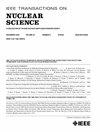The Effect of Heavy-Ion Single Events on the Accuracy of SONOS Analog In-Memory Computing Accelerators
IF 1.9
3区 工程技术
Q3 ENGINEERING, ELECTRICAL & ELECTRONIC
引用次数: 0
Abstract
Silicon-oxide-nitride-oxide–silicon (SONOS) charge-trap memory is a promising nonvolatile memory (NVM) device for analog in-memory computing (AIMC) applications. The sensitivity of 40-nm SONOS analog states in response to single-event effects (SEEs) was experimentally assessed by exposing an SONOS array to heavy ions with the linear energy transfers (LETs) of 28.6, 44.9, and 59.5 MeV/(mg/cm2). A statistical model of SEE was developed using specific criteria to distinguish them from effects unrelated to radiation, such as device-to-device programming variation, read noise, and drift. This model was used to simulate the effects of heavy ions on an AIMC accelerator processing standard deep neural networks (DNNs) running inference on common datasets, including ImageNet. Simulated inference accuracy decreases with increasing LET and fluence. At the highest LET of 59.5 MeV/(mg/cm2), an accuracy degradation of 5% on ImageNet was predicted at a fluence of重离子单事件对SONOS模拟内存计算加速器精度的影响
二氧化硅-氮化氧化物-硅(SONOS)电荷陷阱存储器是一种很有前途的非易失性存储器(NVM)器件,用于模拟内存计算(AIMC)应用。通过将SONOS阵列暴露于28.6、44.9和59.5 MeV/(mg/cm2)的线性能量转移(let)重离子中,实验评估了40 nm SONOS模拟态对单事件效应(SEEs)的灵敏度。使用特定标准开发了SEE的统计模型,以区分与辐射无关的影响,例如设备到设备的编程变化,读取噪声和漂移。该模型用于模拟重离子对AIMC加速器的影响,该加速器处理标准深度神经网络(dnn)在常用数据集(包括ImageNet)上运行推理。模拟推理精度随LET和影响力的增大而降低。在最高LET为59.5 MeV/(mg/cm2)时,预计ImageNet在3\ × 10^{6}$ ions/cm2的影响下精度下降5%,这表明在大多数空间应用中具有足够的性能。
本文章由计算机程序翻译,如有差异,请以英文原文为准。
求助全文
约1分钟内获得全文
求助全文
来源期刊

IEEE Transactions on Nuclear Science
工程技术-工程:电子与电气
CiteScore
3.70
自引率
27.80%
发文量
314
审稿时长
6.2 months
期刊介绍:
The IEEE Transactions on Nuclear Science is a publication of the IEEE Nuclear and Plasma Sciences Society. It is viewed as the primary source of technical information in many of the areas it covers. As judged by JCR impact factor, TNS consistently ranks in the top five journals in the category of Nuclear Science & Technology. It has one of the higher immediacy indices, indicating that the information it publishes is viewed as timely, and has a relatively long citation half-life, indicating that the published information also is viewed as valuable for a number of years.
The IEEE Transactions on Nuclear Science is published bimonthly. Its scope includes all aspects of the theory and application of nuclear science and engineering. It focuses on instrumentation for the detection and measurement of ionizing radiation; particle accelerators and their controls; nuclear medicine and its application; effects of radiation on materials, components, and systems; reactor instrumentation and controls; and measurement of radiation in space.
 求助内容:
求助内容: 应助结果提醒方式:
应助结果提醒方式:


